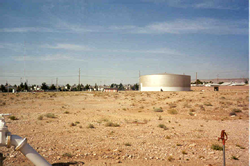|
This research project focuses on the application of dust
suppressants and
palliatives to disturbed lands in Southern Nevada. The
U.S. Environmental
Protection Agency (EPA) has established air quality standards for
fine
particulate matter (PM-10) which are generated from unpaved roads and
parking lots, vacant lots that have been graded, and construction sites.
To
minimize the generation of dust from these surfaces, EPA has recommended
the use of dust suppressants and soil stabilizers. Different categories
of
dust suppressants include: Water Absorbing (e.g., Magnesium Chloride,
Calcium Chloride); Organic Petroleum (e.g., asphalt emulsion); Organic
Non-Petroleum (e.g., vegetable oil, molasses); and Synthetic Polymer
Emulsions (e.g., soil sement).
These suppressants are generally effective for minimizing dust; however,
the knowledge of their environmental impacts is limited. Thus, the overall
goal of the proposed research is to provide a scientific basis for
evaluating the water quality impacts of the major categories of dust
suppressants and soil stabilizers. It is proposed to obtain this scientific
data through field experiments with dust suppressants over an 18 month
period. The results of this study will provide a scientific basis for
proposed regulations on the application of dust suppressants on disturbed
lands.
This research is supported by the Clark
County Health District, Las
Vegas
Valley Water District, Clark
County Flood Control District, City
of Las
Vegas, and University
and Community College System of Nevada (UCCSN) through the Applied
Research Initiative (ARI).
|
|
|
 |
|




